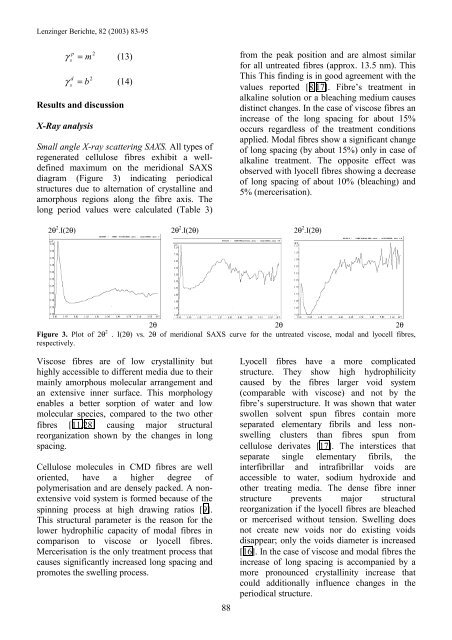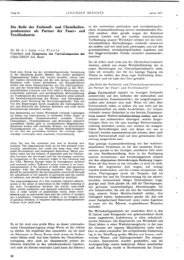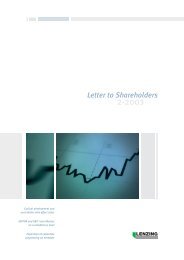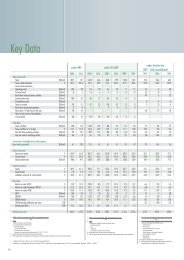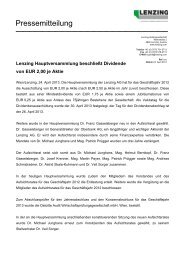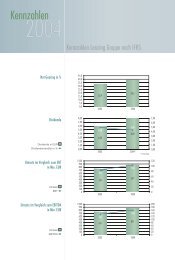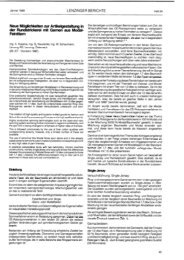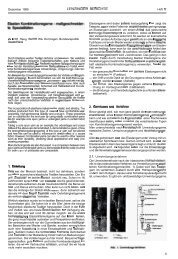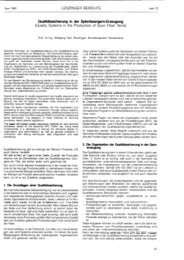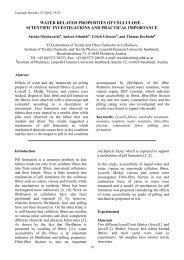Correlation of regenerated fibres morphology and surface ... - Lenzing
Correlation of regenerated fibres morphology and surface ... - Lenzing
Correlation of regenerated fibres morphology and surface ... - Lenzing
Create successful ePaper yourself
Turn your PDF publications into a flip-book with our unique Google optimized e-Paper software.
<strong>Lenzing</strong>er Berichte, 82 (2003) 83-95<br />
p 2<br />
γ m (13)<br />
s =<br />
d 2<br />
γ b (14)<br />
s =<br />
Results <strong>and</strong> discussion<br />
X-Ray analysis<br />
Small angle X-ray scattering SAXS. All types <strong>of</strong><br />
<strong>regenerated</strong> cellulose <strong>fibres</strong> exhibit a welldefined<br />
maximum on the meridional SAXS<br />
diagram (Figure 3) indicating periodical<br />
structures due to alternation <strong>of</strong> crystalline <strong>and</strong><br />
amorphous regions along the fibre axis. The<br />
long period values were calculated (Table 3)<br />
2θ 2 .I(2θ) 2θ 2 .I(2θ) 2θ 2 .I(2θ)<br />
88<br />
from the peak position <strong>and</strong> are almost similar<br />
for all untreated <strong>fibres</strong> (approx. 13.5 nm). This<br />
This This finding is in good agreement with the<br />
values reported [8,17]. Fibre’s treatment in<br />
alkaline solution or a bleaching medium causes<br />
distinct changes. In the case <strong>of</strong> viscose <strong>fibres</strong> an<br />
increase <strong>of</strong> the long spacing for about 15%<br />
occurs regardless <strong>of</strong> the treatment conditions<br />
applied. Modal <strong>fibres</strong> show a significant change<br />
<strong>of</strong> long spacing (by about 15%) only in case <strong>of</strong><br />
alkaline treatment. The opposite effect was<br />
observed with lyocell <strong>fibres</strong> showing a decrease<br />
<strong>of</strong> long spacing <strong>of</strong> about 10% (bleaching) <strong>and</strong><br />
5% (mercerisation).<br />
2θ 2θ 2θ<br />
Figure 3. Plot <strong>of</strong> 2θ 2 . I(2θ) vs. 2θ <strong>of</strong> meridional SAXS curve for the untreated viscose, modal <strong>and</strong> lyocell <strong>fibres</strong>,<br />
respectively.<br />
Viscose <strong>fibres</strong> are <strong>of</strong> low crystallinity but<br />
highly accessible to different media due to their<br />
mainly amorphous molecular arrangement <strong>and</strong><br />
an extensive inner <strong>surface</strong>. This <strong>morphology</strong><br />
enables a better sorption <strong>of</strong> water <strong>and</strong> low<br />
molecular species, compared to the two other<br />
<strong>fibres</strong> [11,28] causing major structural<br />
reorganization shown by the changes in long<br />
spacing.<br />
Cellulose molecules in CMD <strong>fibres</strong> are well<br />
oriented, have a higher degree <strong>of</strong><br />
polymerisation <strong>and</strong> are densely packed. A nonextensive<br />
void system is formed because <strong>of</strong> the<br />
spinning process at high drawing ratios [9].<br />
This structural parameter is the reason for the<br />
lower hydrophilic capacity <strong>of</strong> modal <strong>fibres</strong> in<br />
comparison to viscose or lyocell <strong>fibres</strong>.<br />
Mercerisation is the only treatment process that<br />
causes significantly increased long spacing <strong>and</strong><br />
promotes the swelling process.<br />
Lyocell <strong>fibres</strong> have a more complicated<br />
structure. They show high hydrophilicity<br />
caused by the <strong>fibres</strong> larger void system<br />
(comparable with viscose) <strong>and</strong> not by the<br />
fibre’s superstructure. It was shown that water<br />
swollen solvent spun <strong>fibres</strong> contain more<br />
separated elementary fibrils <strong>and</strong> less nonswelling<br />
clusters than <strong>fibres</strong> spun from<br />
cellulose derivates [17]. The interstices that<br />
separate single elementary fibrils, the<br />
interfibrillar <strong>and</strong> intrafibrillar voids are<br />
accessible to water, sodium hydroxide <strong>and</strong><br />
other treating media. The dense fibre inner<br />
structure prevents major structural<br />
reorganization if the lyocell <strong>fibres</strong> are bleached<br />
or mercerised without tension. Swelling does<br />
not create new voids nor do existing voids<br />
disappear; only the voids diameter is increased<br />
[16]. In the case <strong>of</strong> viscose <strong>and</strong> modal <strong>fibres</strong> the<br />
increase <strong>of</strong> long spacing is accompanied by a<br />
more pronounced crystallinity increase that<br />
could additionally influence changes in the<br />
periodical structure.


